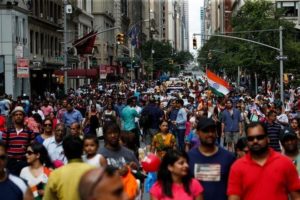Indian diaspora to play key role in US elections 2020
Indian diaspora in US accounts for over 1.5 million registered voters. Little wonder then that both the Republicans and Democrats are wooing Indian Americans for November’s Presidential elections.
In September last year, when over 50,000 Indians gathered for the hyped up Howdy Modi event in Houston, it was the the largest-ever political meeting addressed by a foreign leader in the United States. Yet, instead of being uneasy about political activities of a foreign politician, US President Donald Trump not only welcomed the meeting, but also turned up at the NRG Stadium to share the dais with Indian Prime Minister Narendra Modi.
Indeed, it was seen as a win-win by both. For Modi, it marked the highpoint of his proactive policy of connecting with Indian diaspora. Trump got his reward when Modi broke all diplomatic protocols to endorse Trump’s re-election bid asking the Indian diaspora to vote for him. For Trump, the other objective of participating in the Houston meet was the relatively deep purse of an average member of the Indian diaspora, the richest ethnic group in the country, in order to fund his re-election bid.
Indeed, as the 2020 Presidential campaign enters its final weeks, both the Democrats and the Republicans have reinforced their efforts to woo the Indian community. In order to connect with Indian populace in the US, the Democratic Party’s candidate former Vice President Joe Biden’s campaign team announced the launch of its massive outreach programme in 14 languages, acknowledging the linguistic diversity of the ethnic community.
The Democratic campaigning took a cue from Indian electoral politics and coined the slogan ‘America Ka Neta Kaisa Ho, Joe Biden Jaisa Ho’ (America’s leader should be like Joe Biden), and this is just one of many examples. The slogan was created to generate enthusiasm among Indian-American voters in the US, just like it is widely used in India during election campaigns and rallies.
The Democrats are working closely with the Asian American and Pacific Islander (AAPI) Team to communicate directly with Indian-American citizens in more than 14 languages, which includes Hindi, Punjabi, Tamil, Telugu, Bengali, Urdu, Kannada, Malayalam, Oriya, Marathi and Nepali.
“The Indian-American vote can be an absolute difference-maker,” says Thomas Perez, chair of the Democratic National Committee. Perez was speaking at a virtual event ‘An Electorate Coming of Age: Indian Americans for Biden’, jointly hosted by the South Asians for Biden along with AAPI Victory Fund and Indian-American Impact Fund.
The rise of a strict nationalist narrative in India under Prime Minister Narendra Modi’s government has largely helped shift the political paradigm for the diaspora, who strongly identify with India’s rising stature in the global arena. Indian Americans are the second-largest immigrant group in the US after Mexicans.
In February this year, a few days after President Donald Trump flew back from his visit to India after “Namaste Trump” event, joined by a massive rally with 100,000 supporters, the Republican presidential campaign launched a few digital ads focussed for a very specific demographic in the US-Indian Americans.
One Facebook ad featured Trump and First Lady Melania Trump standing in front of Taj Mahal. “Indian Americans are titans of business, masters of the arts and innovate technology like few others,” the ad read. “Your contributions have strengthened our culture and economy. I will always fight for you!” Another one said “America loves India,” and featured a photo of Trump and Modi together. “Our economies have never been better, and the United States is eager to build a strong partnership with India.”
Education linkages between India and the US are one of the strongest in the world, and any discourse around Indian diaspora is incomplete without talking about students. From just one student in 1883, US universities now house more than 200,000 Indian students. Indian students who went to the US for higher education contributed over $8 billion in 2018-19 to the US economy.
Hence, addressing the matters of education among the diaspora is a key element. Another digital advertisement showed a photograph of PM Modi and listed education policies the Trump administration backs, including tax breaks to support private and religious school scholarships.
With so many accolades for the Indian diaspora in US presidential election campaigns from the both parties, and expansion of slogans and digital advertisements aiming to appease the community; it will be rather interesting to witness the role Indian diaspora plays in the upcoming elections, set to take place in November this year.
Media reports quote Amit Jani, the national AAPI director for the Biden campaign as saying that the Indian-American community has grown in size, influence and in political and civic involvement. More Indian-Americans are joining politics and government. “The election in November for the president is going to be historic, and we really need the help and support from the Indian-American community to really make a difference,” Jani was quoted as saying.
Indeed, irrespective of who the winner is on the night of November 3, expect the Indian American community to play an increasingly important role in the new White House team as well as in various states of the US.










